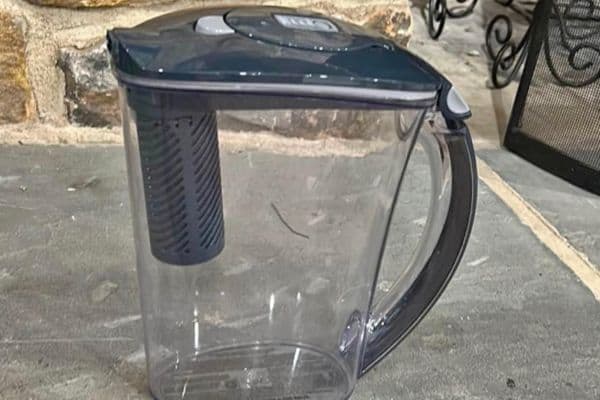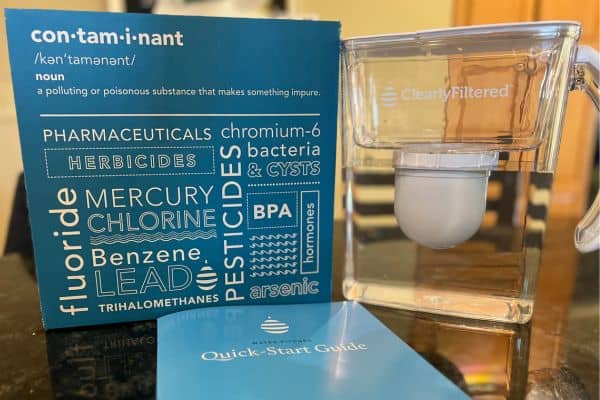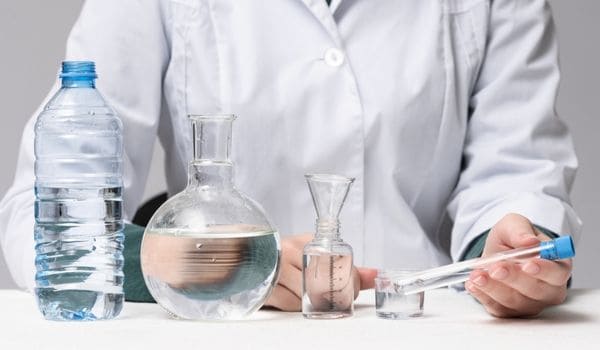If you’re filling up a glass expecting clean, pure water — you might be surprised to learn what’s actually in it.
PFAS, known as “forever chemicals,” have been making headlines — and they’re sneaky. They’re not just found in raincoats and pizza boxes anymore — they’re turning up in drinking water too. 😬
This has sparked a big question: Can popular filters like Brita actually remove PFAS?
The short answer? Kind of — but it’s complicated.
We’re gonna break down Brita’s actual PFAS removal capabilities — why filtering these chemicals is so tricky, and what better options you might want to consider.
Let’s dive in.
🧠 Quick Takeaways
- ✅ PFAS (“forever chemicals”) are widespread and hard to remove from water.
- ✅ Brita’s Elite Filter can reduce some PFAS — but results vary by contaminant.
- ✅ Standard Brita filters are not certified for PFAS removal.
- ✅ Better-performing filters (like Clearly Filtered) offer stronger protection.
- ✅ Lab testing and EPA guidelines show PFAS removal isn’t one-size-fits-all.
🧪 What Are PFAS (and Why Are They So Hard to Filter Out)?

PFAS (short for per- and polyfluoroalkyl substances) are man-made chemicals used in products like non-stick cookware, waterproof jackets, fast-food wrappers, and even firefighting foam.
They’re called “forever chemicals” because they barely break down — meaning they stick around in our environment (and bodies) for decades. 😬
🔎 Key facts about PFAS:
- Extremely small and slippery at a molecular level (hard for normal filters to trap).
- Linked to health issues like: cancer, hormone disruption, immune problems, and developmental delays.
- Common in tap water supplies across the U.S. — even after basic municipal treatment.
- The EPA considers them an urgent public health concern (source).
💬 Good to Know: Filtering PFAS isn’t as simple as tossing in a carbon filter. Removing them effectively usually requires very specific types of filtration — like advanced carbon blocks, reverse osmosis membranes, or specialized resins.
💬 Health Note: Long-term PFAS exposure is no joke — studies link it to serious risks like cancer, hormone disruption, liver damage, and developmental problems (EPA). That’s why strong filtration (and strong regulation) matters more than ever.
🏛️ Regulation and Awareness: The PFAS Wake-Up Call

For a long time, PFAS flew under the regulatory radar. But not anymore. 🚨
With growing public pressure and mounting scientific evidence — government agencies are finally stepping up. The EPA’s roadmap for PFAS action marks a huge shift toward tougher rules, stricter testing, and (eventually) enforceable drinking water limits.
- ✅ Some states have already set their own aggressive standards.
- ✅ Lawsuits and public outcry, have pushed companies to phase out certain PFAS chemicals.
- ✅ Water utilities across the country are being forced to test for — and address — PFAS contamination.
💬 Good to Know: It’s still a work in progress. Federal regulations for PFAS aren’t uniform yet — and many existing “limits” are based on voluntary guidelines, not hard laws. Staying informed and filtering your own water remains one of the best ways to protect yourself in the meantime.
🛡️ The Challenge of Filtering PFAS
Getting rid of PFAS isn’t as simple as running your water through a basic filter. These chemicals are slippery — designed to resist breaking down in water, heat, and even strong chemicals.
- ✅ Standard carbon filters (like basic Brita models) might improve taste and remove chlorine, but most aren’t built to tackle stubborn PFAS molecules.
- ✅ Removing PFAS properly usually requires activated carbon designed for PFAS, ion exchange resins, or reverse osmosis membranes — technologies that specifically target microscopic contaminants.
- ✅ Even filters that claim to reduce PFAS need to be backed by independent testing or certifications to be trusted fully.
💬 Good to Know: According to the EPA’s guide to PFAS treatment options, activated carbon and reverse osmosis are two of the most effective methods available today.uned.
🧹 Brita’s Approach to Water Filtration

Brita has built its name on improving: taste, smell, and basic safety of tap water — but when it comes to PFAS, the story gets a little more complicated.
- ✅ Filtration Tech: Most Brita filters use activated carbon and ion exchange resins, which are great for grabbing chlorine, lead, and some heavy metals.
- ✅ PFAS Removal? Some Brita filters — like the Elite (formerly Longlast) — show partial PFAS reduction in certain tests, but standard Brita filters aren’t officially certified to fully remove PFAS.
- ✅ Performance Details: You can check Brita’s own Performance Data Sheet to see what each filter targets. Spoiler: PFAS isn’t always prominently listed unless you’re using the Elite model.
💬 Good to Know: The EPA recommends specific filtration technologies for PFAS — and while Brita’s Elite filters have shown promising results for certain PFAS compounds, basic models aren’t enough if PFAS are a real concern.
🔎 Brita and PFAS: What’s the Verdict?

When it comes to PFAS, the truth about Brita filters is… a bit of a mixed bag. 🎭
- ✅ Elite Filters (formerly Longlast): Brita’s performance data shows their Elite filters can reduce up to 98.1% of certain PFAS compounds, like PFOA and PFOS.
- ✅ Standard Pitcher Filters: Brita’s basic filters focus more on chlorine and taste/odor — and aren’t certified for PFAS reduction.
- ✅ Stream and Bottle Filters: Great for convenience and flavor, but not designed to remove PFAS at meaningful levels.
Here’s a quick side-by-side:
| 🔍 Filter Type | ⚡ PFAS Removal Claimed? | ✅ Notes |
|---|---|---|
| Elite (Longlast+) Filter | Yes | Reduces ~98% of PFOA/PFOS; tested and certified for some PFAS |
| Standard Pitcher Filter | No | Good for chlorine and metals — but not PFAS-specific |
| Stream Filter | No | Designed for taste improvement; fast flow |
| Bottle Filter | No | Convenient for on-the-go, but not PFAS-rated |
💬 Good to Know: Even Brita’s best filter isn’t a silver bullet for every PFAS type — and effectiveness can vary based on your local water quality.
📚 Consumer Reports and Studies: How Does Brita Really Perform?

When it comes to PFAS, it’s not enough to rely on brand claims alone. 📋 Independent studies with government guidance can really help you see what’s going on.
🔎 Consumer Reports Testing (2020):
- They found that while Brita Elite filters helped reduce some PFAS compounds, the reductions weren’t always complete.
- Standard Brita filters (and similar models) showed little to no PFAS removal.
- Other brands, like Clearly Filtered and dedicated PFAS-rated systems, performed significantly better for wide PFAS coverage.
🔎 EPA’s Treatment Guide:
- The EPA’s Drinking Water Treatment Technology Options clearly states that granular activated carbon (GAC) — like Brita uses — can be effective but depends heavily on:
- Contact time (how long water touches the filter)
- The specific types of PFAS
- Regular filter changes to avoid saturation
💬 Good to Know: A Brita Elite filter can help reduce basic PFAS levels, but it’s not designed to capture the full spectrum of PFAS like some higher-end systems.
🌎 Brita’s Place in a PFAS-Conscious World

Brita has earned its reputation for making tap water taste better — no doubt about it. But in today’s world, where PFAS contamination is a rising concern, taste isn’t enough anymore. Consumers are looking for real protection against these persistent chemicals.
Here’s how Brita fits into the bigger picture:
- ✅ Transparency: Brita openly shares its performance data sheets, showing that the Elite (Longlast+) filter can reduce some PFAS. That’s more than most brands disclose.
- ✅ Accessibility: Brita pitchers are affordable, easy to find, and simple to use — making basic filtration available to millions of households.
- ⚠️ Limitations: Brita’s filters, even the Elite, were not specifically engineered only for PFAS removal. They reduce some compounds, but not the full spectrum that newer technologies are targeting.
💬 Good to Know: If your main concern is taste, chlorine, or basic sediment, Brita is still a solid choice. But if you’re battling known PFAS contamination, it’s smart to consider a filter system verified for broader PFAS removal.at you’re buying. Now, let’s see how Clearly Filtered compares when it comes to getting rid of PFAS.
🥊 Brita vs Clearly Filtered: Which One Handles PFAS Better?
When it comes to PFAS removal, not all water pitchers are created equal. Here’s how Brita stacks up against a more specialized option, Clearly Filtered:

| Feature | Brita Filters | Clearly Filtered |
|---|---|---|
| PFAS Removal | Partial (only Elite filter reduces some types) | Extensively tested — removes up to 99.5% of PFAS |
| Independent Testing | Limited | Certified third-party lab testing available |
| Filter Lifespan | 2–6 months depending on model | Up to 4 months, depending on usage |
| Other Contaminant Removal | Chlorine, lead (some models) | Over 365+ contaminants including lead, fluoride, BPA |
| Price Point | Lower upfront cost | Higher initial cost, but better long-term protection |
💬 Good to Know: Clearly Filtered uses advanced filtration technology that targets “forever chemicals” much more aggressively than Brita.
(You can check out our full Clearly Filtered Water Pitcher review here if you want the full scoop.)
🧪 Testing Your Water for PFAS (Why It’s Worth It)

Before you invest in a better filter, it’s smart to know exactly what you’re dealing with.
- ✅ Municipal water reports (also called CCRs) can tell you some basics — but PFAS often aren’t included in standard testing.
- ✅ To really know if you have PFAS (and how much), you’ll need specialized testing.
Here’s how to stay one step ahead:
- Check Your Local Water Quality Reports: Some areas list PFAS results, but not all.
- Use a Professional Lab Test: For the most accurate PFAS detection, a certified lab test is your best bet.
- Home Kits (With a Caveat): Some home kits exist, but make sure they’re validated for PFAS — many are not.
💧 Pro Tip: Our go-to for accurate PFAS water testing? SimpleLab’s Tap Score service.
It’s affordable, easy to use — gives you a full breakdown of what’s hiding in your water.
💬 Good to Know: Regular testing is important — especially if your area is near factories, airports, military bases, or landfills where PFAS contamination tends to be higher.our needs.
🧼 Bottom Line

Brita filters — especially the Elite model — can reduce some PFAS compounds.
But if you want serious protection against these persistent chemicals, they’re not the strongest option out there.
- ✅ Brita Elite: Can help reduce certain PFAS (confirmed for some types, but not all).
- ✅ Standard and Stream Filters: Better for taste and odor, but not built for PFAS removal.
- ✅ Clearly Filtered: A more robust solution, independently tested and verified for higher PFAS reduction.
💧 Pro Tip: Always read a filter’s performance data sheet — real protection means real testing, not just marketing claims. If you’re ready to level up your water safety, explore filters specifically designed for PFAS removal to find options that truly deliver.
💬 Good to Know: Whether you stick with Brita, upgrade to something stronger, or test your water first — being informed puts you in control of what’s coming out of your tap.
At the end of the day, your water deserves better — and so do you.
 147 people found this helpful. Was this guide helpful to you?
147 people found this helpful. Was this guide helpful to you? 

